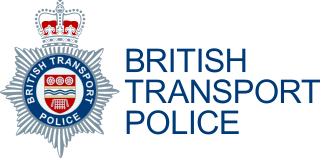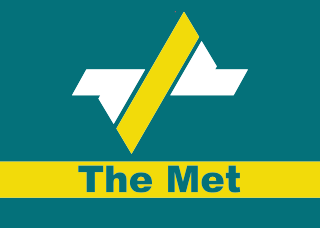British Railways (BR), which from 1965 traded as British Rail, was a state-owned company that operated most of the overground rail transport in Great Britain from 1948 to 1997. It was formed from the nationalisation of the Big Four British railway companies, and was privatised in stages between 1994 and 1997. Originally a trading brand of the Railway Executive of the British Transport Commission, it became an independent statutory corporation in January 1963, when it was formally renamed the British Railways Board.

Network Rail Limited is the owner and infrastructure manager of most of the railway network in Great Britain. Network Rail is an "arm's length" public body of the Department for Transport with no shareholders, which reinvests its income in the railways.

The British Transport Police is a national special police force that polices railways and light-rail systems in England, Wales and Scotland, for which it has entered into an agreement to provide such services. The force is funded primarily by the rail industry, and does not receive central government funding. British Transport Police officers do not have jurisdiction in Northern Ireland unless working under mutual aid arrangements for the Police Service of Northern Ireland, in which case any duties performed on a railway will be merely incidental to working as a constable in Northern Ireland.
The British Railways Board (BRB) was a nationalised industry in the United Kingdom that operated from 1963 to 2001. Until 1997 it was responsible for most railway services in Great Britain, trading under the brand name British Railways and, from 1965, British Rail. It did not operate railways in Northern Ireland, where railways were the responsibility of the Government of Northern Ireland.
The Railways Act 1993 was introduced by John Major's Conservative government and passed on 5 November 1993. It provided for the restructuring of the British Railways Board (BRB), the public corporation that owned and operated the national railway system. A few residual responsibilities of the BRB remained with BRB (Residuary) Ltd.
There are effectively two separate mainline railway systems in the United Kingdom – the Great Britain system and the Northern Ireland system, which are regulated and operated separately, and are constituted under separate pieces of United Kingdom legislation.
The privatisation of British Rail was the process by which ownership and operation of the railways of Great Britain passed from government control into private hands. Begun in 1994, it had been completed by 1997. The deregulation of the industry was initiated by EU Directive 91/440 in 1991, which aimed to create a more efficient rail network by creating greater competition.

The Strategic Rail Authority (SRA) was a non-departmental public body in the United Kingdom set up under the Transport Act 2000 to provide strategic direction for the railway industry. Its motto was 'Britain's railway, properly delivered'. It was abolished by the Railways Order 2006, its functions being absorbed by the Department for Transport or the Office of Rail Regulation.

The Office of Rail and Road (ORR) is a non-ministerial government department responsible for the economic and safety regulation of Britain's railways, and the economic monitoring of National Highways.
The State Rail Authority, a former statutory authority of the Government of New South Wales, operated and maintained railways in the Australian state of New South Wales from July 1980 until December 2003.
Eurostar International Limited (EIL) is the railway company operating the international Eurostar train services between London, Paris, Amsterdam and Brussels via the Channel Tunnel. Eurostar was previously operated by three separate companies in Belgium, France and the United Kingdom, but this structure was replaced by EIL as a new single management company on 1 September 2010. EIL is owned by SNCF (55%), Caisse de dépôt et placement du Québec (CDPQ) (30%), Hermes Infrastructure (10%) and NMBS/SNCB (5%).

London and Continental Railways (LCR) is a property development company owned by the Government of the United Kingdom for developing former railway land. The company was originally established in 1994 as a private consortium to own European Passenger Services and build the Channel Tunnel Rail Link (CTRL) under a contract agreed with the government.

Chelfham Viaduct is a railway viaduct built in 1896–97 to carry the Lynton and Barnstaple Railway (L&B) across the Stoke Rivers valley. Designed by L&B engineer, FW Chanter, and containing over a quarter of a million Marland bricks, its eight arches - each 42 feet (13 m) wide and 70 feet (21 m) high - meaning that the 132-yard (121 m)-long viaduct is the largest narrow gauge railway structure in England. Chelfham Viaduct was Bridge number 22 of the 80 that carried or spanned the railway over its 19-mile (31 km) length. The viaduct was classified as a Grade II listed structure on 25 February 1965.
London Regional Transport (LRT) was the organisation responsible for most of the public transport network in London, England, between 1984 and 2000. In common with all London transport authorities from 1933 to 2000, the public name and operational brand of the organisation was London Transport from 1989, but until then it traded as LRT. This policy was reversed after the appointment of Sir Wilfred Newton in 1989, who also abolished the recently devised LRT logo and restored the traditional roundel.
The Director of Passenger Rail Franchising was a statutory office in the United Kingdom created in 1993 by the Railways Act 1993 and usually called the Franchising Director. It lasted from 5 November 1993 until 31 January 2001 when it was superseded by the Strategic Rail Authority.

The Public Transport Corporation (PTC) was a Government of Victoria owned statutory authority formed under the Transport Act 1983 which operated passenger and freight trains, trams and bus services.

VicTrack, the trading name of Victorian Rail Track Corporation, is a Victorian Government state-owned enterprise which owns all railway and tram lines, associated rail lands and other rail-related infrastructure in the state of Victoria, Australia, with the exception of the Emerald Tourist Railway Board's heritage Puffing Billy Railway.
The Old Dalby Test Track is a railway in the United Kingdom which is used for testing new designs of trains. It runs between Melton Mowbray, Leicestershire and Edwalton, on the course of the Midland Railway's route between Kettering and Nottingham which closed to passengers on 1 May 1967 and to goods in 1968. It is 13.5 miles (21.7 km) in length.

London TravelWatch is a statutory British consumer organisation that campaigns for improvements to transport in London. It deals with all complaints from passengers using any Transport for London modes including some cycling and pedestrian issues, Victoria coach station, passengers using Eurostar, the Heathrow Express rail service to Heathrow Airport and some aspects of rail travel including issues arising from the stations. It also deals with all rail complaints that are outside of the scope of the rail ombudsman and within its geographical remit. It is therefore in consumer representation terms an "appeals body". It is funded by the London Assembly and was established in its current form in July 2000.

Pensford Viaduct is a disused railway bridge in the village of Pensford within the historic English county of Somerset now unitary authority Bath and North East Somerset. It is a Grade II listed building.












